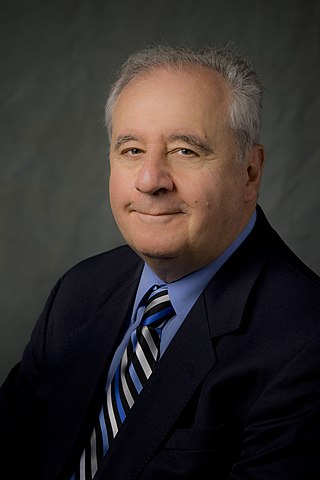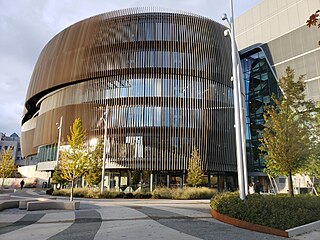Related Research Articles

Civil engineering is a professional engineering discipline that deals with the design, construction, and maintenance of the physical and naturally built environment, including public works such as roads, bridges, canals, dams, airports, sewage systems, pipelines, structural components of buildings, and railways.

ABB Ltd. is a Swedish-Swiss multinational corporation headquartered in Zürich, Switzerland. The company was formed in 1988 when Sweden's Allmänna Svenska Elektriska Aktiebolaget (ASEA) and Switzerland's Brown, Boveri & Cie merged to create ASEA Brown Boveri, later simplified to the initials ABB. Both companies were established in the late 1800s and were major electrical equipment manufacturers, a business that ABB remains active in today. The company has also since expanded to robotics and automation technology.

The American Society of Civil Engineers (ASCE) is a tax-exempt professional body founded in 1852 to represent members of the civil engineering profession worldwide. Headquartered in Reston, Virginia, it is the oldest national engineering society in the United States. Its constitution was based on the older Boston Society of Civil Engineers from 1848.

Henry Petroski was an American engineer specializing in failure analysis. A professor both of civil engineering and history at Duke University, he was also a prolific author. Petroski has written over a dozen books – beginning with To Engineer is Human: The Role of Failure in Successful Design (1985) and including a number of titles detailing the industrial design history of common, everyday objects, such as pencils, paper clips, toothpicks, and silverware. His first book was made into the film When Engineering Fails. He was a frequent lecturer and a columnist for the magazines American Scientist and Prism.

The African Peer Review Mechanism (APRM) is a mutually agreed instrument voluntarily acceded to by the member states of the African Union (AU) as a self-monitoring mechanism. It was founded in 2003.

The American Society for Engineering Education (ASEE) is a non-profit member association, founded in 1893, dedicated to promoting and improving engineering and engineering technology education. The purpose of ASEE is the advancement of education in all of its functions which pertain to engineering and allied branches of science and technology, including the processes of teaching and learning, counseling, research, extension services and public relations. ASEE administers the engineering technology honor society Tau Alpha Pi.

Marine engineering is the engineering of boats, ships, submarines, and any other marine vessel. Here it is also taken to include the engineering of other ocean systems and structures – referred to in certain academic and professional circles as “ocean engineering.”
ISEC may refer to:
Enterprise engineering is the body of knowledge, principles, and practices used to design all or part of an enterprise. An enterprise is a complex socio-technical system that comprises people, information, and technology that interact with each other and their environment in support of a common mission. One definition is: "an enterprise life-cycle oriented discipline for the identification, design, and implementation of enterprises and their continuous evolution", supported by enterprise modelling. The discipline examines each aspect of the enterprise, including business processes, information flows, material flows, and organizational structure. Enterprise engineering may focus on the design of the enterprise as a whole, or on the design and integration of certain business components.

The Earthquake Engineering Research Institute (EERI) is a leading technical society in dissemination of earthquake risk and earthquake engineering research both in the U.S. and globally. EERI members include researchers, geologists, geotechnical engineers, educators, government officials, and building code regulators. Their mission, as stated in their 5-year plan published in 2006, has three points: "Advancing the science and practice of earthquake engineering; Improving understanding of the impact of earthquakes on the physical, social, economic, political, and cultural environment; and Advocating comprehensive and realistic measures for reducing the harmful effects of earthquakes".
Lunarcrete, also known as "mooncrete", an idea first proposed by Larry A. Beyer of the University of Pittsburgh in 1985, is a hypothetical construction aggregate, similar to concrete, formed from lunar regolith, that would reduce the construction costs of building on the Moon. AstroCrete is a more general concept also applicable for Mars.
ASCE Library is an online full-text civil engineering database providing the contents of peer-reviewed journals, proceedings, e-books, and standards published by the American Society of Civil Engineers. The Library offers free access to abstracts of Academic journal articles, proceedings papers, e-books, and standards as well as many e-book chapters. Access to the content is available either by subscription or pay-per-view for individual articles or chapters. E-books and standards can be purchased and downloaded in their entirety. Most references cited by journal articles and proceedings papers in the library are linked to original sources using CrossRef. Linking provides researchers with the ability to link from reference citations to the bibliographic records of other scientific and technical publishers’ articles. ASCE also offers librarians usage statistics which are compliant with the COUNTER Code of Practice for Journals and Databases. All articles are in PDF and many journal articles are also available in HTML format.
Design Automation usually refers to electronic design automation, or Design Automation which is a Product Configurator. Extending Computer-Aided Design (CAD), automated design and Computer-Automated Design (CAutoD) are more concerned with a broader range of applications, such as automotive engineering, civil engineering, composite material design, control engineering, dynamic system identification and optimization, financial systems, industrial equipment, mechatronic systems, steel construction, structural optimisation, and the invention of novel systems.

The Department of Civil and Environmental Engineering is the academic department at Imperial College London dedicated to civil engineering. It is located at the South Kensington Campus in London, along Imperial College Road. The department is currently a part of the college's Faculty of Engineering, which was formed in 2001 when Imperial College restructured. The department has consistently ranked within the top five on the QS World University Rankings in recent years.

Dan Mircea Frangopol is an American civil engineer and the inaugural holder of the Fazlur R. Khan Endowed Chair of Structural Engineering and Architecture at Lehigh University, Bethlehem, Pennsylvania.
The Cambridge Institute for Sustainability Leadership, formerly the Cambridge Programme for Sustainability Leadership and the Cambridge Programme for Industry, is part of the School of Technology within the University of Cambridge.

Nader Bagherzadeh is a professor of computer engineering in the Department of Electrical Engineering and Computer Science at the University of California, Irvine, where he served as a chair from 1998 to 2003. Bagherzadeh has been involved in research and development in the areas of: Computer Architecture, Reconfigurable Computing, VLSI Chip Design, Network-on-Chip, 3D chips, Sensor Networks, Computer Graphics, Memory and Embedded Systems. Bagherzadeh was named Fellow of the Institute of Electrical and Electronics Engineers (IEEE) in 2014 for contributions to the design and analysis of coarse-grained reconfigurable processor architectures. Bagherzadeh has published more than 400 articles in peer-reviewed journals and conferences. He was with AT&T Bell Labs from 1980 to 1984.

Venkatesh Kumar R Kodur is a scientist and university professor, currently at Michigan State University. He was born in Kodur village in Karnataka India, received his bachelor's degree in Civil engineering from the University Visveswaraya College of Engineering, Bangalore, India, in 1984. He received his M.Sc. and Ph.D. degrees from Queen's University at Kingston, Canada, in 1988 and 1992, respectively. Following a brief stint as a Post-doctoral Fellow at Royal Military College, Kingston, Canada, he joined the National Research Council (Canada), where as senior scientist, he carried out extensive research in structural fire safety field. In 2005, he joined the faculty of Michigan State University (MSU), where he is currently a University Distinguished Professor in the Department of Civil & Environmental Engineering. Kodur has established unique fire test facilities and highly acclaimed research program in structural fire engineering area at MSU and is the founding director of the Center on Structural Fire Safety and Diagnostics.

The Interdisciplinary Science and Engineering Complex (ISEC) is a 234,000 square-foot building at Northeastern University designed for collaborative research, laboratory access, and classroom learning. The building is located on the University's central campus at 805 Columbus Ave, Boston, Massachusetts. The building initially opened on April 3, 2017.

Alphose Zingoni is a Zimbabwean–South African engineer and professor of structural engineering and mechanics in the Department of Civil Engineering at the University of Cape Town, and founder of the Structural Engineering, Mechanics & Computation (SEMC) series of international conferences.
References
- ↑ "Structural Engineering Expert Witnesses".
- ↑ "Professor Singh awarded ASCE Construction Management Award". 20 March 2019.
- ↑ "Online Civil Engineering Masters Programs". US News. 11 November 2016. Retrieved 19 July 2023.
- ↑ "Mission of ISEC". International Structural Engineering and Construction Society. Archived from the original on September 17, 2013. Retrieved December 30, 2013.
- ↑ "ISEC | International Structural Engineering and Construction Society". www.isec-society.org. Retrieved 19 July 2023.
- ↑ "ISEC | International Structural Engineering and Construction Society".
- ↑ "Proceedings of International Structural Engineering and Construction".
- ↑ "ISEC | International Structural Engineering and Construction Society".